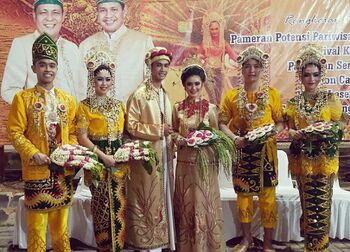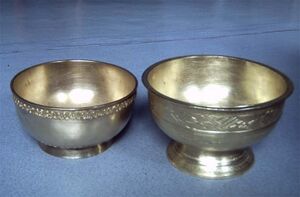بنجر (شعب)
| |
|---|---|
 Three Banjarese couples wearing traditional Banjarese attire (from left to right: Bagajah Gamuling Baular Lulut, Babaju Kun Galuh Pasinan, and Baamar Galung Pancar Surya) in South Kalimantan, Indonesia | |
| إجمالي التعداد | |
| 5.7 million | |
| المناطق ذات التجمعات المعتبرة | |
| 4,127,124 (2010)[1] | |
| 2,686,627 | |
| 464,260 | |
| 440,453 | |
| 227,239 | |
| 125,707 | |
| 102,237 | |
| 14,430 | |
| 12,405 | |
| 11,811 | |
| 9,383 | |
| 8,572 | |
| 62,400[أ][2] | |
| Unknown[ب][3] | |
| اللغات | |
| Banjarese Indonesian Malaysian | |
| الدين | |
| 99.55% Sunni Islam 0.44% Others | |
| الجماعات العرقية ذات الصلة | |
The Banjar or Banjarese (قالب:Lang-bjn; Galambang Banjar) are an Austronesian ethnic group native to the Banjar regions (notably Banjarmasin, Banjarbaru, Banjar Regency, etc.) in the southeastern Kalimantan regions of Indonesia.[1] Nowadays, Banjarese diaspora can be found in neighbouring Banjar regions as well; including Kotabaru Regency, the southeastern regions of Central Kalimantan, southernmost regions of East Kalimantan, and some provinces of Indonesia in general. The Banjarese diaspora community also can be found in neighbouring countries of Indonesia, such as Brunei, Malaysia (notably in Perak, Selangor, Kedah and Johor with significant minorities in Sabah), and Singapore.[4]
أصل الاسم
Etymologically, the word Banjar is derived from terminology in the Janyawai dialect of Ma'anyan language, which rooted from Old Javanese language. It is initially used to identified the Ma'anyan, Meratus Dayak, and Ngaju people who are already "Javanized" when the Javanese people arrived in the southeastern Kalimantan regions to established their civilization. The term banjar (ꦧꦚ꧀ꦗꦂ) itself in Javanese language is a short form of a verb mbanjarke (ꦩ꧀ꦧꦚ꧀ꦗꦂꦏꦺ), which means "to separate and rearrange" literally. It is 'common knowledge' within the communities of South Kalimantan that the Banjarese people were formerly part of larger Dayak community.
التاريخ
Both Proto-Malay people (who were the ancestors of the Dayak people) and the Deutero Malays migrated to Borneo around 2500 BC. Later circa 400 AD, Sumatran brought their culture to Borneo. This cultural fusion led to the birth of the Upper Banjar language (Bahasa Banjar Hulu). In 520 AD, Sumatran immigrants formed the Buddhist Kingdom of Tanjungpuri in the present-day region of Tanjung, Tabalong.[5][6]
In 14th century, Empu Jatmika migrating from Keling, Kediri built the Hindu Kingdom of Negara Dipa by the river of Tapin.[7] Which later came to be ruled under Majapahit's Rajasa dynasty. This was the start of the Javanese-style courts in South Kalimantan. This Hindu era in South Kalimantan remained influential period in South Kalimantan's history. Negara Dipa was succeeded by the Hindu Kingdom of Negara Daha in 15th century.[8]
According to history, Prince Samudera, the rightful heir to the kingdom of Negara Daha, was forced to flee the court of because of his uncle's revolt against him.[9] He was accepted by the people of Bandar Masih (Bandar: port, Masih: Malay people). Supported by the Sultanate of Demak in Java, he formed a new Islamic Banjar Kingdom in 1526 with Bandar Masih as its capital.[10] The name of Bandar Masih was later changed to its present name Banjarmasin.
Since the 19th century, migration of the Banjarese people went as far as the east coast of Sumatra and Malaysia. In Malaysia and Singapore, Banjarnese people are classified as part of the Ethnic Malay.
Sub-ethnicities
The Banjar people can be divided into three ethnicities based on the locations of the assimilation between the Malays, the local Dayaks (Dayak Bukit, Dayak Ma'anyan, Dayak Lawangan, Dayak Ngaju, Dayak Barangas, and Bakumpai), and the Javanese people.
- The Banjarnese Pahuluan, who live in the valleys by the upriver of Meratus mountain ranges.
- The Banjar Batang Banyu, who live in the valleys by the river of Negara.
- The Banjar Kuala, who live in Banjarmasin and Martapura.
Language
The native language of Banjarese people is Banjarese language (Basa Banjar; Jaku Banjar), it is an Austronesian language predominantly spoken in the southeastern Kalimantan regions. The Banjarese language is the de facto lingua franca for various indigenous community especially in South Kalimantan, as well as Central Kalimantan (notably in Seruyan Regency and Sukamara Regency) and East Kalimantan in general.
Sample text
Universal Declaration of Human Rights
The following texts are the Universal Declaration of Human Rights in Banjarese language along with the original declaration in English.
| English[11] | Banjarese |
|---|---|
| Universal Declaration of Human Rights | Parnyatan Hak Urang Barataan |
| Article 1 | Ujah 1 |
| All human beings are born free and equal in dignity and rights. They are endowed with reason and conscience and should act towards one another in a spirit of brotherhood. | Sagala urang hiput babar lik sapala awak barataan. Urang sanyaan dibari nugaraha baakal maigungakan, handak bakawalan nang mambawa sumangat sapaadingan. |
Simple conversation
Here are examples of simple conversation in Banjarese language:
| Banjarese | sapa ngaran pian? |
|---|---|
| English | what is your name? |
| Banjarese | ngaran ulun ... |
|---|---|
| English | my name is ... |
| Banjarese | ulun handak bailang kasidin |
|---|---|
| English | I want to visit there |
الدين
Most Banjarese are adherents of Islam. Islam first arrived in the South Kalimantan region around the 15th century.[6]
Cuisine
العلاقات مع الداياك
The relationship between the Banjar people and the neighboring Dayaks have always been good. Some Dayaks who had converted to Islam have also assimilated into the Banjar culture and call themselves Banjar.[12] The Dayaks also think of the Banjars as their brothers and sisters. This is further strengthened by the fact there are many inter-marriages between the Banjars and the Dayaks, even among the members of the royalty. For example, Biang Lawai, a wife of a Banjar king, was of Dayak Ngaju ethnicity. This means that the Banjarese kings and queens have Dayak lineage in their blood.[13]
According to Meratus Dayak legends, Banjarese and Meratus are descendants of related brothers of Datung Ayuh or Sandayuhan who was the ancestor of Meratus Dayak, while Bambang Basiwara or Intingan who was the ancestors of Bajarese. In the legends, Sandayuhan is strong and good at fighting, while Intingan has weaker physique but greater intelligence.[14] This relationship grew strong when both ethnicities faced colonization by the Dutch in the 18th century. Some of the warriors involved in Banjar War are of Dayak ethnicity or have Dayak lineage in their blood.
أهم الأشخاص
 |
 |
 |
 |
 |
 |
 |
 |
 |
 |
 |
|
See also
- Banjar Malaysians
- Banjar Singaporeans
- Banjarese language
- Banjarese architecture
- بنجرماسين
- كالمينتان الجنوبية
Notelist
- ^ Per the 1947 census in Malay Peninsula; Banjarese were counted as part of the local Malaysian Malays.
- ^ Counted as local "Singaporean Malays".
References
- ^ أ ب (in id)Kewarganegaraan, Suku Bangsa, Agama, dan Bahasa Sehari-hari Penduduk Indonesia (Hasil Sensus Penduduk 2010), Jakarta: Central Bureau of National Statistics of the Republic of Indonesia, 2010, ISBN 978-979-064-417-5, https://www.bps.go.id/pressrelease/download.html?nrbvfeve=MTg1NA%3D%3D&sdfs=ldjfdifsdjkfahi&twoadfnoarfeauf=MjAyMS0wNy0xOSAxNzoyNzo0Ng%3D%3D
- ^ "Indonesian Migration Settlement Malaya" (PDF). ASJ. Retrieved 29 January 2023.
- ^ "Urang Banjar: From South Kalimantan to Singapore". biblioasia. Retrieved 8 October 2022.
- ^ "Etnik Banjar Di Perak" (in Malay). The Malaya Post. 7 December 2020.
{{cite web}}: CS1 maint: unrecognized language (link) - ^ M. Suriansyah Ideham (2007). Urang Banjar Dan Kebudayaannya. Pemerintah Propinsi Kalimantan Selatan. ISBN 978-979-98892-1-8.
- ^ أ ب Minahan, James (2012). Ethnic Groups of South Asia and the Pacific: An Encyclopedia (in الإنجليزية). ABC-CLIO. pp. 28–29. ISBN 978-1-59884-659-1.
- ^ Munoz, Paul Michel (2006). Early Kingdoms of the Indonesian Archipelago and the Malay Peninsula. Editions Didier Millet. pp. 281. ISBN 981-4155-67-5.ISBN 978-981-4155-67-0
- ^ Deni Prasetyo (2009). Mengenal Kerajaan-Kerajaan Nusantara. Pustaka Widyatama. ISBN 978-979-610-309-6.
- ^ Ahmad Gazali Usman (1989). Urang Banjar Dalam Sejarah. Lambung Mangkurat University Press. ISBN 979-8128-16-8.
- ^ Mohamad Idwar Saleh (1981). Banjarmasih: Sejarah Singkat Mengenai Bangkit Dan Berkembangnya Kota Banjarmasin Serta Wilayah Sekitarnya Sampai Dengan Tahun 1950. Museum Negeri Lambung Mangkurat, Propivsi [i.e. Propinsi] Kalimantan Selatan. OCLC 19940334.
- ^ "OHCHR -". www.ohchr.org. Archived from the original on 30 August 2016. Retrieved 16 August 2016.
- ^ Hawkins, Mary (2000). "Becoming Banjar". The Asia Pacific Journal of Anthropology. Informa UK Limited. 1 (1): 24–36. doi:10.1080/14442210010001705830. ISSN 1444-2213.
- ^ Wilson, Wilson (2022-01-15). "Relasi Islam-Dayak di Kota Palangka Raya Kalimantan Tengah". Jurnal Pendidikan Tambusai. 5 (3): 11105–11122. ISSN 2614-3097. Retrieved 2022-10-29.
- ^ "Kisah Datung Ayuh dan Bambang Siwara". Histori. 2017-12-11. Retrieved 2022-10-29.
Further reading
- de Bruyn, W.K.H.F.; Bijdrage tot de kennis van de Afdeeling Hoeloe Soengai, (Zuider a Ooster Afdeeling van Borneo), 19--.
- Broersma, R.;Handel en Bedrijf in Zuiz Oost Borneo, S'Gravenhage, G. Naeff, 1927.
- Eisenberger, J.; Kroniek de Zuider en Ooster Afdeeling van Borneo, Bandjermasin, Drukkerij Lim Hwat Sing, 1936.
- Bondan, A.H.K.; Suluh Sedjarah Kalimantan, Padjar, Banjarmasin, 1953.
- Ras, J.J.; Hikajat Bandjar, A study in Malay Histiography, N.V. de Ned. Boeken, Steen Drukkerij van het H.L. Smits S'Graven hage, 1968.
- Heekeren, C. van.; Helen, Hazen en Honden Zuid Borneo 1942, Den Haag, 1969.
- Riwut, Tjilik; Kalimantan Memanggil, Penerbit Endang, Djakarta.
- Saleh, Idwar; Sejarah Daerah Tematis Zaman Kebangkitan Nasional (1900–1942) di Kalimantan Selatan, Depdikbud, Jakarta, 1986.
External links
 Media related to Banjar people at Wikimedia Commons
Media related to Banjar people at Wikimedia Commons
- Short description is different from Wikidata
- Articles with hatnote templates targeting a nonexistent page
- Articles containing Banjar-language text
- "Related ethnic groups" needing confirmation
- Articles using infobox ethnic group with image parameters
- Articles containing جاوية-language text
- Articles containing لاتينية-language text
- Articles containing هولندية-language text
- Banjar people
- Ethnic groups in Indonesia
- Ethnic groups in Malaysia
- South Kalimantan
- Muslim communities of Indonesia
- Ethnic groups in Singapore
- Sultanate of Banjar

